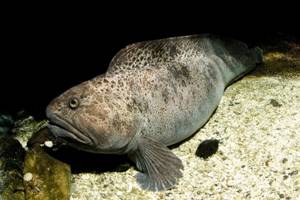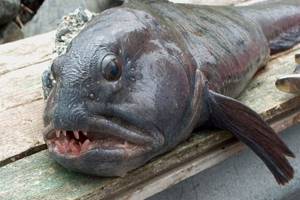Catfish is a predatory sea fish of the Zubatkov family from the ray-finned genus. This aquatic inhabitant looks terrifying: an elongated body without pelvic fins, a wide head with wrinkled skin, large fangs. Due to the presence of 2 rows of strong teeth, the fish received the name “sea wolf”. Some people believe that this predator is no less dangerous than a shark. But in reality, the catfish, reminiscent of a monster from the era of dinosaurs, itself became the object of human hunting.
It lives in the waters of the Atlantic and southern Arctic oceans, in the Barents, Baltic, and White seas. It is imported to the CIS countries from Norway, but Russian residents feast on specimens caught off the coast of Kamchatka. The product is expensive because fishing is difficult due to the catfish's tendency to hide in rocks. This predator is popular among chefs. Its tender, sweetish meat is considered a delicacy and can complement a therapeutic diet for diseases and prevent the occurrence of a number of pathologies.
Far Eastern catfish (Anarhichas orientalis)

In natural habitat

Far Eastern catfish hiding in the rocks

This is how they catch catfish in Norway

Below is detailed information about catfish: how it is useful, what are the disadvantages of this product, popular recipes.
Types of catfish
- Far Eastern catfish. It resembles a moray eel (see photo), lives among stones. It lives off the coast of Kamchatka, in the Chukchi Sea.
- Striped. Has transverse stripes throughout the body. Reaches a length of up to 150 cm. It is found in the Norwegian, Barents, White Seas, and the Atlantic Ocean.
- Sandy or ordinary. The fastest among the representatives of the genus. Found in the Barents Sea, in the north of the Atlantic Ocean.
- Variegated or spotted. Length - up to 180 cm. Caught in the Norwegian and Barents Seas, the Atlantic Ocean.
- Acne. Separated into a separate genus of the family. It reaches more than 2 meters, so it looks thinner than similar fish. Distributed in the Pacific Ocean.
- Blue catfish. Depending on living conditions, it has a gray or blue color. It is confused with the spotted one because their range coincides. The first is larger, prefers to live in deep water, and is more active. The second is fattier, the meat is denser and richer in taste. Motley catfish is in great demand among chefs.

Blue catfish (Anarhichas denticulatus)

What kind of fish is this and where does it live?
Externally, catfish is very similar to an eel or moray eel. She has the same long body, which wriggles like a snake while moving underwater. At the same time, the marine inhabitant is not even distantly related to eels and moray eels. The catfish belongs to the ray-finned family and the order Perciformes.
The marine resident got its name because of its characteristic appearance. This fish has very large fangs that protrude from its mouth. The sea wolf needs such teeth to effectively capture and hold prey. In addition, this predator often has to bite through shells and shells, and this activity requires really powerful jaws. Interestingly, unlike other marine inhabitants, this fish is able to change its teeth approximately once a year.
There are 5 types of catfish:
- Striped.
- Blue.
- Spotted.
- Far Eastern.
Representatives of the ray-finned family differ in size and habitat. The largest representatives are the Blue and Spotted catfish. The length of adult individuals reaches 180 cm, and the weight is 20 kg.
Where are the fish found:
- Pacific Ocean.
- Waters of the North Atlantic.
- Atlantic Ocean.

Beneficial features
Meat of all types of catfish has beneficial properties:
- Reduces the concentration of cholesterol in the body.
- Gives elasticity to blood vessels.
- Strengthens the immune system.
- Prevents the development of neuroses and depression.
- Improves vision, memory, brain activity.
- Normalizes the functioning of the thyroid gland.
- Reduces the likelihood of developing cancer.
- Activates the removal of salts from the body.
- Strengthens bone tissue.
- Takes care of hair and tightens skin.
- Normalizes hematopoiesis.
- Improves the functioning of the gastrointestinal tract.
The benefits of catfish

The majority of nutritionists are convinced that the meat of this representative of the living environment is perfectly digestible and is saturated with a variety of positive substances.
Useful qualities of the product:
- enrichment of cells with proteins involved in the structure of the body;
- removal of excess salt and the body, fight against edema;
- improving the immune system, increasing resistance to viruses and infectious diseases;
- stabilization of the functioning of the nervous system;
- proper functioning of the thyroid gland;
- active cholesterol removal;
- normalization of the cardiovascular system;
- establishing pH balance;
- memory improvement;
- normalization of pressure; burning excess fat.
Contraindications and possible harm
Contraindications to eating catfish are allergies to fish of its family. The daily norm for men and women is 150-200 g, for children - 60-150 g. Excessive use leads to the accumulation of mercury and heavy metals in the body, which are found in all marine life. You can consume the product 2 times a week, but if certain conditions are detected, you should stop using it for a while.
Catfish can cause harm, not benefit, in the following cases:
- Hyperthyroidism and diseases associated with excess iodine in the body. “Sea Wolf” is one of the leaders in the content of this element. If consumed, the patient's condition may worsen.
- Enzyme deficiency. With pathology, the fats contained in fish are digested slowly, so complications arise.

Benefits for the body
The rich composition determines all its beneficial properties. Its use has a positive effect on the condition of the skin, internal organs, as well as the nervous system and general emotional state.
- First of all, it is useful for people with problems of the cardiovascular system. Due to the presence of large amounts of potassium, magnesium, omega-3 and 6, harmful cholesterol is removed from the body, reducing the risk of atherosclerosis and clogging of veins. Potassium in the composition reduces swelling and stabilizes blood pressure. Thanks to it, excess salt is removed from the body. And since it is excess salt that provokes some diseases of the joints, kidneys and blood vessels, it has a beneficial effect on them too. For people with ischemia and arterial hypertension, doctors prescribe its mandatory use. It is also useful for blood clotting problems.
- During recovery from serious illnesses and fractures, doctors strongly recommend including catfish in the diet. A large amount of nutrients and vitamins allows you to reduce rehabilitation time and return to a full life earlier.
- The iodine in the composition helps with thyroid problems.
- This type of fish is often recommended for people who are depressed. Eating it for breakfast can significantly improve your mood for the whole day.
- The protein contained in fish is much healthier than what is found in meat and even poultry; it is absorbed faster and has a more positive effect on cells and muscle mass. Athletes and patients during recovery include it in their diet precisely because of its positive effects on the body.
- By eating a portion of catfish just twice a month, you can provide your body with vitamins A, B, E, D, PP.
- The abundance of vitamins and microelements not only allows you to cope with many diseases, but also improves immunity.
- Regular consumption of fish stimulates brain activity, strengthens muscles, and increases the elasticity of skin and tissues.
Is it possible for children
Feeding catfish is allowed from 3 years of age. This fish is not bony and rarely causes allergies. When prepared correctly and following the recommended standards, the product brings considerable benefits to the child:
- promotes mental activity;
- prevents the development of rickets;
- increases immunity;
- stimulates muscle growth.

Variegated or spotted catfish (Anarhichas minor)
What fish products should not be offered to children?
- Even adults should eat all kinds of canned sprat, sprat or herring in limited quantities. For children, especially, we choose something more dietary.
- Semi-finished products from fish raw materials and “crab” sticks from minced fish - we exclude surrogates from the children's menu.
- Nutritionists advise giving smoked fish only to older children.
- Exotic fish, as well as seafood - due to the high sensitivity of the children's digestive system.
- Caviar, as it is too fatty for small children.
- Fish that doesn't make you feel confident about its freshness.
Recommendations from nutritionists for losing weight
Catfish is low-fat, nutritionists advise including it in the diet. The product helps fight indigestion, lack of nutrients in the body, and fluid retention.
For greater effect, you should adhere to the following principles:
- eat boiled, stewed or steamed fish;
- completely avoid salty, smoked, fried foods;
- add food rich in coarse fiber to the menu;
- maintain physical activity.

What are the benefits of catfish?
General benefit
Catfish contains a large amount of iodine, which is why it is recommended for people with thyroid problems. It contains many protein compounds that are necessary for children, the elderly, pregnant and nursing mothers. Omega-3 contained in the composition reduces cholesterol.

Catfish fillet, due to the content of valuable elements in it, is recommended for people suffering from cardiovascular diseases. Catfish has a beneficial effect on cerebral circulation, inhibits the development of atherosclerosis and plaques, and strengthens the immune system.
Thanks to potassium, catfish removes excess salt and relieves swelling. Vitamin D has a beneficial effect on blood clotting, strengthens bone and muscle tissue, and the nervous system. And vitamin PP prevents the development of atherosclerosis.
Regular consumption of catfish helps:
- in case of digestive disorders;
- hypertension;
- unstable metabolism in the body;
- ischemia.
Catfish meat is recommended for all people without exception, from children to the elderly. It is especially useful for women during pregnancy and lactation.
Due to its composition and low calorie content, sea wolf meat can be classified as a dietary product. With the help of fish fillet, it is not difficult to maintain the body’s performance at the required level. Catfish meat supports muscle tissue and does not allow fibers to break down, much less contribute to their reduction. When carrying out a diet with catfish, the weight decreases gradually, due to the gradual destruction of fatty layers. Moreover, there is no shortage of minerals and other useful substances.
Worth knowing!
Catfish cannot completely replace other products. It can only replenish the missing elements in the body. It is enough to take meat 2 times every 7 days to reduce the calorie intake per day.
You can use sea wolf fillet during fasting days. But you shouldn’t overuse it, 2 times a week is enough.
For women
Sea wolf fillet is good for women, especially for those who watch their figure. With its help you can lose weight or spend fasting days. It will fill the body with all the necessary minerals, vitamins and microelements, so there will be no shortage of nutrients during the diet.
In addition, catfish prolongs youth, as it has a beneficial effect on the functioning of almost all body systems. To have fresh skin, healthy hair and nails, you need to include sea wolf fillet in your diet.
For men
For the stronger sex, catfish will be no less useful than for women. Protein, which is part of meat, removes toxins and reduces cholesterol, normalizes metabolic processes.
Thanks to vitamin D present in fish, bone tissue is strengthened. Regular consumption of catfish strengthens muscle mass.
During pregnancy
Pregnant women will benefit from catfish in moderation. Fish will help replenish the body with the necessary beneficial elements, remove excess fluid and relieve swelling.
Regular consumption of sea wolf meat will have a positive effect on the development of the fetus and the health of the woman herself.
Video:
how to eat healthy during pregnancy
When breastfeeding
“Sea wolf” is recommended to be included in the diet of women during lactation. It cannot be said that meat can increase or speed up milk production, but fish will definitely improve the quality of milk. Due to this, the baby will be able to receive the most useful and valuable substances that are necessary for development. And the woman herself will recover faster after childbirth.
For children
The child's body constantly requires vitamins, minerals, micro- and macroelements. Therefore, eating catfish will come in handy for children. In addition, it has been proven that fish meat improves memory and has a beneficial effect on brain function. Due to the content of useful substances in it, the child will strengthen bone and muscle tissue.
Another important point of including catfish in a child’s diet is the fact that regular consumption of fish meat strengthens the immune system, improves overall well-being, and saturates the body’s cells and tissues with essential substances.
When losing weight
Catfish meat can be classified as a dietary product. If you steam or boil the fish, the calorie content will be low
Considering its usefulness and importance for the body, it is not difficult to lose weight with its help. It is clear that the process will not be quick, but fats will leave the body forever
Chemical composition and calorie content
Fish meat and caviar are saturated with omega-3 and omega-6 fatty acids and amino acids, vitamins B, C, E, PP, A, D. The product contains the following micro and macroelements:
- calcium;
- magnesium;
- iron;
- zinc;
- potassium;
- iodine;
- copper;
- sodium;
- manganese;
- phosphorus;
- chlorine;
- fluorine;
- sulfur;
- chromium;
- cobalt;
- nickel;
- molybdenum.
Calorie content of 100 g of raw fillet is 108–126 kcal. Speckled catfish has the fewest calories. Fats in the product are 5.2–5.8%, proteins are 16–20%, carbohydrates are 0%.

Table of the energy value of fish for various cooking methods:
| Processing method | Kcal per 100 g |
| Cooking | 114 |
| For a couple | 115 |
| Baking | 137 |
| Frying with oil | 195–214 |
| Grilled | 178 |
| Salting | 125 |
| Hot smoking | 130–138 |
| Cold smoking | 117 |
| Drying | 114–130 |

This is how catfish is dried

Catfish with cabbage, celery and miso sauce

Ingredients:
- 200 g catfish fillet;
- 150 grams of white cabbage;
- 115 g soy sauce;
- 10 grams each of olive and green oil;
- 100 grams of pineapple juice, honey, sugar;
- 50 grams each of celery and miso paste.
Preparation:
- If you choose this dish, you will be provided with tasty and juicy catfish, the calorie content of which will remain low and the nutritional value will be maximum.
- To make miso sauce, combine honey, juice, soy sauce, sugar and miso paste. Melt these products in a saucepan, stirring constantly. After 10 minutes the sauce is ready. Use it to marinate fish fillets.
- After an hour, place it on a baking sheet with parchment paper and bake at 180 degrees for about 12 minutes.
- Add soy sauce to the fried cabbage. Simmer this vegetable over low heat, covered with a lid, until it is ready. Then fry it until delicious golden brown.
- Green oil is obtained by beating olive oil with the addition of salt and chopped parsley. Use a blender for this purpose.
Well, celery puree is prepared as follows:
- the prepared root is cut into pieces;
- fried in olive oil;
- stewed with 300 grams of water and a pinch of salt;
- beat in a blender bowl.
When serving, celery puree, a little green butter and baked fish fillet with fried cabbage are laid out on a portioned dish.
Catfish is not as common a fish in the diet of our compatriots as some of its other marine “relatives”. But this does not mean that “sea wolf” is worse - you just need to know how to choose and prepare it. Knowledge in these matters will ensure that catfish dishes taste wonderful. Well, nature itself made sure that they benefit the body, endowing the meat of these sea creatures with numerous valuable components
However, it is important to remember that excessive consumption can make catfish an enemy of our body.
The main habitat of catfish is the northern waters of the Atlantic and Pacific Oceans. People call catfish “sea wolf” because of its appearance.
Among the beneficial substances that catfish contains are antioxidants, minerals, trace elements and vitamins. They have a positive effect on the condition of the skin, internal organs and mood. Catfish contains a lot of protein, which is why athletes eat the fish.
The beneficial amino acids in catfish are responsible for the normal functioning of the heart and blood vessels. Phosphorus and magnesium are beneficial for human bones.
Fatty catfish contains unsaturated fatty acids Omega-3 and Omega-6.
Magnesium is involved in protein, fat and energy metabolism. By eating catfish at least twice a month, you will receive a set of vitamins: A, B, E, D, PP.
Benefits and harms for various diseases
Fish meat can speed up recovery and prevent diseases. But the product can also cause harm. Consider the effects on the body:
- Diabetes. “Sea wolf” accelerates the removal of cholesterol and reduces blood sugar levels; patients are recommended to include it in the menu. But the fish needs to be prepared correctly - boiled, baked. Salted, fried and smoked products have a harmful effect on diabetics: they provoke fluid retention, increase blood pressure and glucose levels.
- Pancreatitis. Catfish protein is quickly absorbed and does not create unnecessary stress on the pancreas, helps speed up metabolism, and prevents exhaustion. But if the pathology worsens, use is prohibited: the inflamed organ cannot cope with fats.
- Gastritis. Boiled and steamed catfish is useful for chronic disease in remission. It provides the body with the substances necessary for digestion. In the acute stage of gastritis, fish is not allowed.
- Iodine deficiency pathologies of the thyroid gland. Catfish is called an essential source of iodine. 100 g of fillet contains more than 30% of the daily requirement. But you can’t eat fish exclusively: an excess of microelements also provokes pathologies.
- Atherosclerosis. The product contains fatty acids that prevent the accumulation of cholesterol and maintain the elasticity of blood vessels. Catfish does not harm the patient if the recommended consumption standards are observed.
How to cook properly

To get as much benefit as possible from eating sea wolf, it must be prepared correctly. If you want to preserve as many nutrients as possible in fish, boil it, stew it, bake it, or use a double boiler.
It is better to avoid frying or resort to it as rarely as possible, because this method of cooking contributes to the appearance in the dish of a large number of carcinogens that are harmful to the human body.
How to choose how much to store
Fresh frozen and chilled carcasses and steaks are supplied to stores. When choosing a product, consider:
- Catfish meat is white, reminiscent of butterfish fillet.
- The eyes should be clear and protruding. Cloudiness and hollowness indicate that the catfish has been frozen repeatedly.
- Fresh chilled fish is elastic and has a pleasant sea smell.
- The gill color of a quality catfish is red or pink.
- The frozen carcass should be straight, without creases or cuts in the skin.
- A good product has all the scales that fit tightly to the body.

Store the fish in the refrigerator for up to 24 hours, covering it with ice. In the freezer - up to 2 months.
What kind of fish can children under one year old eat?
At this age, the body is quite whimsical, so according to tradition, all the best and safest is for kids. Some tips for choosing fish for small children:
Marine or freshwater
Nutritionists agree that sea and ocean fish are the most suitable for introducing a baby to this product. Firstly, because it is the most environmentally friendly. Secondly, it contains more nutrients. And thirdly, there are fewer bones and they are larger, so you are more likely to fillet them.

Red or white
Red fish is very popular among adults, but for children aged 10 months it is better to eat white fish. It is less allergenic.
Do you know that the red color of some types of fish is due to their diet - they eat reddish crustaceans. This red pigment accumulates and gives their meat its color.
By fat content
Fish seems to us to be one of the most dietary foods. This is true, but do not forget that some varieties can contain more than 30% fat. In the first months of life, the child should try only low-fat varieties of fish (no more than 4% fat), as they are digested faster and easier. These can be: hake, flounder, cod.
Leave medium-fat fish (for example, catfish or sea bass) until they are one and a half years old.
Frozen or fresh
Of course, freshly caught fish is the best option for first feeding. The main thing is to choose it correctly. A product with a smell (even a slight one) – we immediately say “no” to the seller. To properly appreciate the aroma of the fish, try to bend back its gills - there should be no smell in this place other than the sea.
Fresh fish should also have:
- Beautiful colour
- Clear eyes
- Elastic and shiny scales
Don't be too afraid of fresh frozen fish. If stored correctly, the product will not be inferior in beneficial properties to fresh. If you trust the seller, you can safely take the frozen one. Defrost it slowly, first in the refrigerator and then at room temperature - this will preserve its texture.
What to pay attention to: Frozen fish should not have a thick ice crust. This appearance suggests that it has already been defrosted. But such a product should not be consumed by adults, much less small children.

Smoked, salted, dried, dried catfish
Salted and dried catfish is in great demand as a cold snack. Smoked fish is an even more popular product.
Before serving one of these products, know:
- Salted catfish is very soft and difficult to cut into pieces. However, the fish is tasty and goes well as a side dish. After cooking, all beneficial substances are retained in the product, but catfish becomes dangerous for people with kidney and heart diseases. The salt with which the meat is soaked provokes fluid retention, which causes the deposition of stones and increased blood pressure.
- Dried fish is denser than the previous product and seems fattier. This type of catfish retains its original set of vitamins and minerals. But it is prepared with a lot of salt and can provoke swelling, increased blood pressure, and urolithiasis.
- Dried fish turns out to be hard, but when it weathers, liquid comes out of it. The pros and cons of the product are the same as dried ones. But due to water evaporation, the fillet becomes more nutritious.
- Smoked catfish has a sweetish-spicy taste and smoky aroma. Eat alone or add to salads. This kind of fish meat is healthy: it doesn’t heat up too much during cooking, and most of the vitamins are retained. But it is dangerous because, under the influence of smoke, carcinogens are formed in it, which activate the growth of malignant cells.

Smoked catfish brings the greatest harm to the body. The negative impact of salted, dried and dried fish depends on the amount eaten. In small doses the product is useful, but if abused it becomes dangerous.
How to cook delicious catfish
There are about fifty recipes for preparing this fish - from classic to extravagant. Fish is consumed in a wide variety of forms - from boiled to grilled. It goes into pickling, baking, soups and so on.
Catfish is most popular, oddly enough, when fried. It’s strange because this fish is dietary, but fried catfish has the maximum calorie content.
The cooking recipe is as follows:
- The fish is cut into steaks, they are salted and settled for about an hour.
- Steaks are dipped in batter and fried in vegetable oil over high heat. The oil level should reach half the thickness of the steak.
- Steaks are fried on both sides until crisp.
- The heat is reduced to ¼ maximum, and each side of each steak is fried for another 5 minutes until done.
The standard egg batter is used: flour, water and salt are added to the beaten eggs, after which the mixture is beaten again and spices are added to it. An alternative is to use regular breadcrumbs instead of batter.

The main secret in cooking is simple - the meat should communicate freely with large volumes of air, there should not be too tight enclosed spaces. Otherwise, the meat will lose its texture, in other words, it will fall apart. If cooked in foil, squeeze it thoroughly to remove as much moisture as possible.











